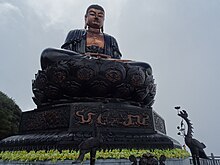
Back البوذية في فيتنام Arabic ভিয়েতনামে বৌদ্ধধর্ম Bengali/Bangla Bouddhisme au Viêt Nam French Buddhizmus Vietnámban Hungarian Buddhisme di Vietnam ID Buddismo in Vietnam Italian ベトナムの仏教 Japanese ព្រះពុទ្ធសាសនានៅវៀតណាម Cambodian 베트남의 불교 Korean व्हियेतनाममधील बौद्ध धर्म Marathi
Buddhism in Vietnam (Vietnamese: Đạo Phật, 道佛 or Phật Giáo, 佛教), as practiced by the Vietnamese people, is a form of East Asian Mahayana Buddhism. It is the main religion in Vietnam. According to the Vietnamese government's 2019 National Population and Housing Census, approximately 4.6 million individuals identified as Buddhists, representing about 4.8% of the total population at that time. However, the U.S. Department of State's 2023 Report on International Religious Freedom cites Vietnam's "White Book" indicates that the Buddhist population increased from nearly 10 million in 2008 to approximately 14 million in 2021 which accounts for 13.3% of the overall population of Vietnam.[1]
 | |
 Bái Đính Temple in Ninh Bình Province, Vietnam | |
| Total population | |
|---|---|
| Estimates vary, around 10 million to 15 million 10%-15% of the total population | |
| Regions with significant populations | |
| Throughout Vietnam | |
| Religions | |
| Mahayana Buddhism, Theravada Buddhism | |
| Languages | |
| Vietnamese |
Buddhism may have first come to Vietnam as early as the 3rd or 2nd century BCE from the Indian subcontinent or from China in the 1st or 2nd century CE.[2] Vietnamese Buddhism has had a syncretic relationship with certain elements of Taoism, Chinese spirituality, and Vietnamese folk religion.[3] Theravada Buddhism also exists, as well as indigenous forms of Vietnamese Buddhism such as Bửu Sơn Kỳ Hương and Hòa Hảo.
Vietnamese Buddhism is generally inclusive and syncretic, drawing on the main Chinese Buddhist traditions, such as Tiantai (Vietnamese: Thiên Thai) and Huayan (Hoa Nghiêm), Zen (Thiền), and Pure Land (Tịnh Độ).[4][5][6]

- ^ "Vietnam". United States Department of State. Retrieved 2025-01-17.
- ^ Cuong Tu Nguyen. Zen in Medieval Vietnam: A Study of the Thiền Uyển Tập Anh. Honolulu: University of Hawaii Press, 1997, pg 9.
- ^ Cuong Tu Nguyen & A.W. Barber 1998, pg 132.
- ^ Cuong Tu Nguyen & A.W. Barber. "Vietnamese Buddhism in North America: Tradition and Acculturation". in Charles S. Prebish and Kenneth K. Tanaka (eds). The Faces of Buddhism in America. Berkeley: University of California Press, 1998, pg 130.
- ^ "Buddhist Studies: Mahayana Buddhism: Vietnam". www.buddhanet.net. Retrieved 2023-05-14.
- ^ Prebish, Charles. Tanaka, Kenneth. The Faces of Buddhism in America. 1998. p. 134